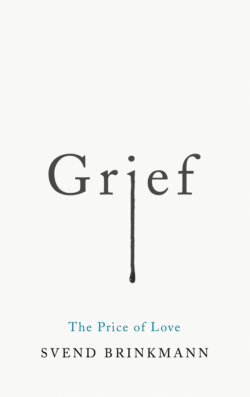Читать книгу Grief - Svend Brinkmann - Страница 6
1 Introduction: The Century of Grief
ОглавлениеGrief has taken centre stage in how we reflect on life – not just in private, enclosed spaces, but also in public debate. The evidence is unavoidable. In the cultural sphere, interest in the phenomenon is reflected by the preponderance of grief-based memoirs and television documentaries. Musicians including Nick Cave, Arcade Fire, Mount Eerie, Leonard Cohen and David Bowie have all released albums and songs on the subject – the latter two almost literally sang their way to their graves. Bereavement discussion groups, cafés, operas and plays have emerged, and social media has created new spaces for sharing experiences of loss, grief and absence.
Michael Hviid Jacobsen, a sociologist specialising in death, has said that we live in ‘the century of grief’, which in his view began with the terrorist attacks of 11 September 2001.1 Once a taboo subject, grief has entered the public sphere and collective consciousness, a trend that has coincided with a process of medicalisation that has situated grief in a healthcare context, culminating in the psychiatric diagnosis ‘complicated grief’. The diagnosis seems set to reinforce the tendency to view grief as a medical and psychological matter, rather than an existential or religious one. At the same time, a range of organisations have also come to the fore that offer treatment to people whose parents, siblings or children are seriously ill or have died.
The century of grief is a ‘post-secular’ era, in which it is no longer widely believed that religion will peter out (McLennan 2010). We are witnessing a general revival of interest in religious, spiritual and existential questions – and grief , as a phenomenon, lies at the heart of these issues. The premise of this book is that grief is a basic existential phenomenon that occurs when love and death intersect. In order to experience the deep grief covered by this book, it is necessary to understand that a deceased loved one is irrevocably lost. Without love on the one hand, and an awareness of death’s inevitability on the other, there is no genuine human grief. This brings us to the central thesis of this book: that humankind can be categorised as a grieving animal, because it appears to be a defining characteristic of our species that we are capable of relating profoundly and intimately to both love and death, which is a prerequisite for the ability to feel genuine grief. Other animals clearly feel separation anxiety and stress, and they too can have persistent, affective relationships with other beings that appear reminiscent of human love (think of the faithful dog). However, the book contends that it is only on the surface that other species appear to feel grief. Genuine grief is reserved for humankind, for better or worse. Worse, because grief hurts; better, because it is a meaningful pain, one that informs the entire network of emotional relationships that constitute the basic psychological substance of our lives. It is through grief that we maintain our bonds with the dead. Grief is – as is quite often and probably rightly said – the price we pay for love.
The philosopher Simon Critchley expresses a similar thought when he writes that the death of a loved one puts us in a position of ‘radical impossibility’ (2010: 40). It is an event over which we have no control. It is impossible to will the other’s death away. There is nothing we can do. According to Critchley, the grief we feel invades and structures our subjectivity. He believes that humans can ultimately be categorised by our ability to grieve, and I concur (see especially Chapter 2). Grief tells us that we can never completely master life. We are forever doomed to fall short due to our dependency on others, who vanish from our lives. This may render us impotent, existentially speaking, but according to Critchley it is precisely this impotence, this fundamental fragility, that creates the ethical demand in our interactions with others. In that sense, grief and ethical life are interlinked.
This realisation – that grief is not just a simple pain to be cured, like a headache, but a meaningful experience following a loss – is reflected in popular culture. It is increasingly recognised that the goal is not to erase grief, to ‘move on’ and leave the dead behind, but to continue living with them. This is entirely consistent with recent grief theories, which emphasise continuing bonds (Klass, Silverman and Nickman 1996), whereas Freud, for example, believed that we should sever ties with the dead and reinvest our mental energy in new relationships (Freud 2005). New relationships can, of course, be significant and life-giving, but, thankfully, few would now argue that they should be at the expense of emotional bonds to the dead. If I may allow myself to be normative here, at the beginning of the book, it is a central part of my thesis that we should incorporate the dead into our lives, not shut them out. But what does this mean in a day-to-day context?
